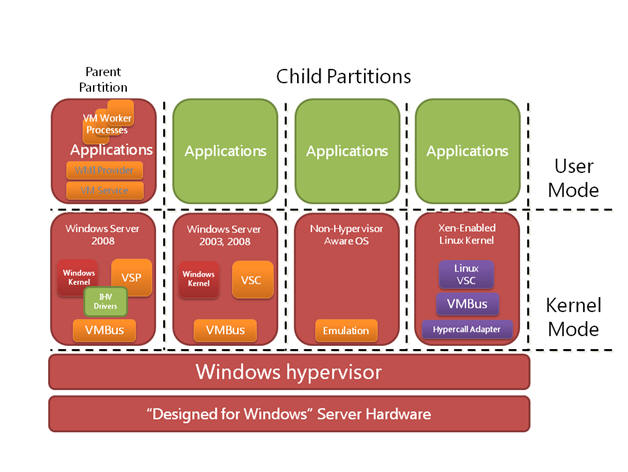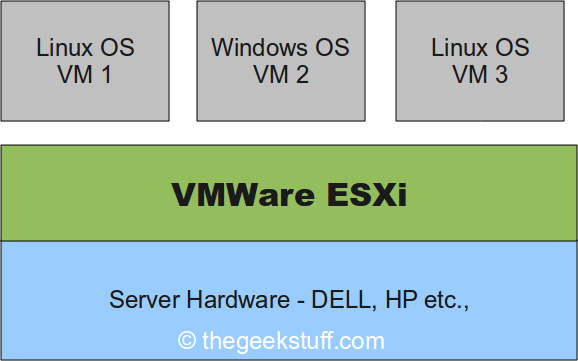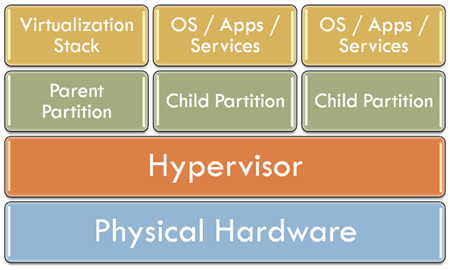What would your recommendation be for a Type 1 Hypervisor - including backup and restoration options
-
-
Hyper-V Architecture
Hyper-V is a so called hypervisor. The hypervisor is installed between the hardware and the operating system. Hyper-V is a role in Windows Server 2008 and can only be installed after Windows Server 2008 is installed. When installing the Hyper-V role the hypervisor is “slid” between the hardware and the operating system. Besides the hypervisor a little more is installed as well. The VMBus is installed which is running in kernel mode as well as a Virtual Storage Provider (VSP). Furthermore a WMI provider is installed which is running in User Mode. A VMWorker process is spawn for every Virtual Machine that’s started when Hyper-V is running.
After installing the Hyper-V role in Windows Server 2008 the server needs to be rebooted and the server is operational. The original Windows Server 2008 that was installed is turned into a Virtual Machine as well, this one is called the “root” or the “parent partition”. It is a very special Virtual Machine since it controls the other Virtual Machines running on the server. I’ll get back to this later in this article.
Virtual Machines and the parent partition on Hyper-V are running side-by-side as shown in

-
Adding to confusion... Hyper-V was sometimes called "Windows hypervisor" and Type 1 was often called "hypervisor virtualization" in the 2008 era. But just marketing terms being thrown around.
-
-
Hyper-V team themselves talking about architecture in 2008.
"Hypervisor is very thin and runs on the hardware itself."
-
@scottalanmiller said in What would your recommendation be for a Type 1 Hypervisor - including backup and restoration options:
But I would say that making wild counter-industry claims of a conspiracy to cover up systems architectures, going against a decade of discussion on this very topic, is something that should be held back if you don't have the time to really delve into it. Knowing that you are trying to completely redefine OS, kernel, hypervisor, hypervisor types, Hyper-V history... all of those things are fine, but it is a bit of a crusade that takes a lot of time.
I specifically remember this being a huge problem for MS, because they couldn't pretty much go the KVM route on server 2008, and them fixing the issue by changing direction and replicating Xen's architecture (and actually hiring Xen engineers to do that).
I also remember some private demos MS gave us for hyper-v on pre-release versions of 2008 and experimental 2003 builds that were, frankly, horrible. But all that was in 2007, so I might be confusing the dates here a bit.
As for crusades, I don't really care enough to make a real issue out of it, I'm just annoyed by marketing people peddling "baremetal", double kernel design as better because "baremetal". to illustrate my point, I'll just leave this here:

-
I found a 2008 source that disagrees with everyone else, but doesn't agree with you either. Just random and, in reality, their diagram is impossible and just shows that they don't understand how it works as their diagram isn't plausible. This is Dell's explanation from the time.
-
@dyasny said in What would your recommendation be for a Type 1 Hypervisor - including backup and restoration options:
I specifically remember this being a huge problem for MS, because they couldn't pretty much go the KVM route on server 2008, and them fixing the issue by changing direction and replicating Xen's architecture (and actually hiring Xen engineers to do that).
I also remember some private demos MS gave us for hyper-v on pre-release versions of 2008 and experimental 2003 builds that were, frankly, horrible. But all that was in 2007, so I might be confusing the dates here a bit.
Before releasing, they likely tried a lot of stuff. They were doing Type 2 before Hyper-V and it was awful. And I'm sure they tried lots of stuff before the 2008 release. But the first release of Hyper-V to the public and the first with that name, was definitely the "Xen way." It was considered a Xen clone since it was Veridian.
-
@dyasny said in What would your recommendation be for a Type 1 Hypervisor - including backup and restoration options:
As for crusades, I don't really care enough to make a real issue out of it, I'm just annoyed by marketing people peddling "baremetal", double kernel design as better because "baremetal". to illustrate my point, I'll just leave this here:

That's fine, and I see what you are trying to say now. You are trying to make the unofficial "Type 0" argument. Basically KVM and ESXi claim to have a superior Type 1 architecture to a point that they sometimes get called "Type 0" to differentiate themselves from other Type 1s.
But given the definition of Type 1, they are both Type 1, just two different approaches. And I don't think that anyone is thinking that the "Xen Way" is better, only that the differences aren't related to Type 1 vs Type 2. Just that some products are better than others, even within the same category.
I think you are trying to find a way for it to be the Type 1 or bare metal nature that is the cause, but it's not.
And a Type 2 architecture is far more different still. What defines T1 v T2 is all in the first interface layer. All of the "good bits" of KVM are in a layer that is "above" the interface point that defines which type is which.
-
@scottalanmiller now that IS funny - Dell was where I worked at the time, and all the demos MS tried to give us for weeks failed one after the other. Compared to a perfectly stable vsphere 2 lab we had on the floor then, it was especially fun.
-
@dyasny said in What would your recommendation be for a Type 1 Hypervisor - including backup and restoration options:
@scottalanmiller now that IS funny - Dell was where I worked at the time, and all the demos MS tried to give us for weeks failed one after the other. Compared to a perfectly stable vsphere 2 lab we had on the floor then, it was especially fun.
I had stability issues with ESX even as late as 4 in production.
Also funnily... same era (pre-Hyper-V) I had to train the ESX engineers from VMware as to how their architecture worked. Because they were copying Xen at the time, too, but weren't being too public about it and even their trainers didn't know how it worked. It was obvious when using it that it was Type 1 with RHEL 2.1 in the Dom0, and common sense suggested that that is how they would have done it at the time, but their own engineers had no idea. But VMware themselves didn't hide it, we were able to pull out their white papers and prove it to engineering.
That was the start of my distrust of the VMware cult, though. The lack of knowledge from VMware made me very worried about their ability to support something if they didn't even know the basics that someone who'd never used it could see in ten minutes.
-
@dyasny are you actually Curtis with a new display name?
-
ESXi is even simpler still than KVM. It's hypervisor kernel is all inclusive and there is no bloat. KVM, in theory, can get to this but requires a ton of work that no one wants to do because the KVM approach is good enough.

-
just...wow
-
@scottalanmiller oh I've had a distrust for VMWare from the very start. When I see an explicit ban on publishing benchmarks in the EULA, I know something is fishy.
-
@dyasny said in What would your recommendation be for a Type 1 Hypervisor - including backup and restoration options:
@scottalanmiller oh I've had a distrust for VMWare from the very start. When I see an explicit ban on publishing benchmarks in the EULA, I know something is fishy.
Doesn't Proxmox do this as well?
-
Even in the Xen vs. KVM space, it's hard to tell who does it better. The gap between the type 1 and the type 2 world tends to be big, but the gaps within the type 1 world are very small, and testing often shows Xen beating KVM, even recently. Part of the problem is that they are not always directly comparable, and your workload matters a lot. Xen tends to have a Linux advantage, but KVM has a Windows one. So your mix of workloads matters heavily.
And, of course, if you run pure Linux workloads, one has to wonder why you'd consider either when Type-C, like LXC, is going to beat the pants off of them either way.
https://www.phoronix.com/scan.php?page=article&item=ubuntu-1510-virt&num=5
That's really where Xen loses, the place where it is the strongest against KVM is also where it is the weakest against LXC.
-
@DustinB3403 said in What would your recommendation be for a Type 1 Hypervisor - including backup and restoration options:
@dyasny said in What would your recommendation be for a Type 1 Hypervisor - including backup and restoration options:
@scottalanmiller oh I've had a distrust for VMWare from the very start. When I see an explicit ban on publishing benchmarks in the EULA, I know something is fishy.
Doesn't Proxmox do this as well?
I doubt that they can, since they are repackaging things that would allow it. Not sure how they could make a EULA in that way.
They just threaten people who talk about them.
-
@dyasny said in What would your recommendation be for a Type 1 Hypervisor - including backup and restoration options:
@scottalanmiller oh I've had a distrust for VMWare from the very start. When I see an explicit ban on publishing benchmarks in the EULA, I know something is fishy.
*cough* Nutanxi *cough*
-
@scottalanmiller "bloat" isn't really relevant, because KVM doesn't really use or involve a lot of the stuff the Linux kernel has. Sure, some disk space gets wasted and boot times might be slightly longer, but that's not really a problem. But the fact that new schedulers and subsystems don't need to be written, and a lot of the stuff that already exists and works can be simply reused is very appealing (to me and probably any unixway geek out there)

